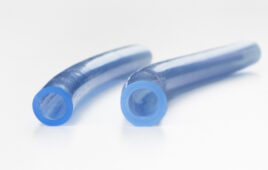
Fictiv co-founder and CEO Dave Evans [Photo courtesy of Fictiv]
Fictiv co-founder and CEO Dave Evans has built a business around solving that challenge. San Francisco–based Fictiv finds and vets contract manufacturers to connect them with companies like medical device developers.
After closing a $100 million Series E funding round this spring, Evans spoke with Medical Design & Outsourcing to share some tips and tricks around vetting potential manufacturing partners. This conversation has been lightly edited for space and clarity.
MDO: What are the biggest things you look for?
Evans: You want to look at that manufacturing partner and say, “What are they really, really good at? What is their core expertise?'”Because what happens — especially in the medical contract manufacturing (CM) world — let’s say they start off and they’re really good with a certain type of PCBA or a certain chip set. From there they tend to add all these capabilities on to get more and more business. So they might add plastic injection molding or they might add wiring harnesses. But these aren’t core capabilities. And then even beyond that second layer, they start building a network of suppliers in their world where they are outsourcing that work. Let’s say they outsource sheet metal — that outsource manufacturer then might outsource the powder coating or the threading or welding that goes on it. So all of a sudden if you are an engineering manager at a medical device company, you might be choosing that contract manufacturer because of a core capability, but then you’re leveraging them for all these other things which become second-, third- and fourth-tier, kind of like arm’s distance away. Then when you’re expecting a device to come back on June 15 and it’s late, it generally isn’t that first party’s fault. It’s the third, fourth and fifth layer. And so one of the things that we actually require in our vetting of the 250 manufacturing partners is there’s no subcontracting allowed. … How much data do these manufacturers you’re looking at have on a quality rating, both in terms of an in-spec rating and on-time delivery? How much outsourcing are they doing and how much control of their supply chain do they really have? These should be big, big questions as you’re looking to really vet your supply base.
MDO: Is it a warning sign if they won’t hand that over?
Evans: Yeah, generally a red flag. Most of those CMs will say, “We don’t share our network of all our vendors, that’s our core IP.” Or they’re like, “Yeah, we don’t want to tell you our on-time performance.” And generally, it’s because they don’t have the data, because a lot of that on-time information lives in spreadsheets and maybe some ERP system, if they have it.
MDO: How do you zero in on a company’s core competencies and what they do better than anyone else?
Evans: I always start by looking in the mirror. For Fictiv, first and foremost, I think why people choose us is quality. Our digital systems combined with our people within this whole network gets you a better quality product out the door. Then we go to these suppliers and we say, “Our job is to bring on the best manufacturing partners to deliver quality.” What do we look for there? We want to look for not just one good product, but how have you done that over an entire year? What audits have you done both internally, but also from ISO or certifications? What are your practices for constantly reevaluating your system? Do you have a lean manufacturing principal, do you have Six Sigma experts that are constantly looking at continuous improvement practices? How are your people treated? What is your minimum pay? What does your turnover and retention rate look like? There’s this whole list, think of it as a hundred-point checklist that we go through to say, is this a world-class manufacturing facility?
MDO: What are you looking for when visiting in person?
Evans: We’re looking at shift schedules, machine maintenance logs, work travelers and how parts flow through a facility. We’re talking to upper management and talking about workforce retention all the way through to how’s the quality department run and what practices do you have in place, what’s written down? And then we’re running real test parts through that to validate that workflow. … There’s a whole team of people and that’s their full-time job. We have folks full-time in India, in China, in the United States, We operate in 27 states in the U.S.
MDO: Do you prefer partners with remote workforces?
Evans: 100%. Remote employees are happier, more productive and you get to leverage the talents of the world, let alone just geographically in the U.S. … I think you build a more resilient workforce as well that way.
MDO: What’s the No. 1 red flag you look for?
Evans: The future is pretty volatile and opaque right now. We have still a pandemic going on, we have a global conflict, we have volatility in the financial markets. There’s never been a more important time to have plan A, B and C, and to have real agility built into your strategy where you can move as things move. Whether you’re running a manufacturing facility or you’re building medical equipment, what’s your agility plan? Do you have one? And if you don’t, that’s a big red flag.
MDO: What are some green lights you love to see?
Evans: Folks who are open to change, especially in the medical world where there’s a lot of risk. The creativity to leverage technology outside of the medical industry, maybe to bring it in and try things in a new way, those are folks that I think are really excelling in this environment. We could see that across the board with all the medical innovations over the last two years as it relates to the pandemic. Having an appetite to try new things — those tend to be guiding lights.
MDO: What are some exciting innovations you’re seeing in the industry?
Evans: Especially on the medical side and in a lot of the mechanical aspects of plastics and metals, we’re seeing a hybrid approach. So you might 3D print something and then machine it for tolerances. You are taking geometries which could never be produced before, but you’re getting the precision of a lot of traditional processes. This combo of additive plus subtractive is really exciting. There’s a lot of work being done in the resin space as well for different medical devices that need biocompatibility. Say for injection molding, we’re seeing a lot of work where injection molding is being used earlier in the development process, whereas traditionally I think a lot of medical device companies really waited into the final stages of, say an FDA trial approval for real materials. For example, we’re turning around injection molded parts in two and a half weeks, so that’s really changing new product development where folks are leveraging injection molding earlier on in their development cycle.








